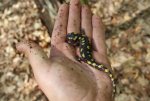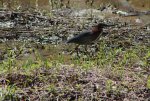Jefferson
Active member
- Joined
- Apr 21, 2012
- Messages
- 190
- Reaction score
- 28
- Points
- 28
- Location
- Southwest Missouri
- Country
- United States
Yesterday morning, under foggy skies and beleaguered of Washington DC, I left for the outlying areas on the Virginia side of the capital, where the strip malls and cookie-cutter housing developments begin to yield to long-abandoned tobacco fields, their soil exhausted by the Republic's Founding, and horse pastures. Ostensibly, I was going after the Spotted Turtle but not really expecting much, just needing some time away from the hustle and bustle. The morning's first stop, nestled beautifully along the sloshing Potomac, had a plethora of calling frogs at it in the morning humidity, and a log-rolling (as they say in the capitol, meaning exchange of support for bills between congressmen) search for salamanders turned up the day's first solid find amongst some old deciduous trees along a ravine: Spotted Salamander.
The rest of the boggy location (which is still nice because the mosquitoes aren't out quite yet in force) yielded nothing of note, and I put on some Charley Pride to get me to my next stop, a large marsh that is made up of very shallow, slowly-flowing water. Here, streams from the Piedmont of Virginia disperse over wide tracts of land as they encounter the flat Potomac floodplain, creating a pristine marsh with perfect habitat for turtles and frogs. I was in luck, as the sun emerged from the clouds an hour before I hit the site, which consequently yielded the day's best finds: Red-eared slider (lifer), Spotted turtle, Snapping turtle, Ribbon snake, and Eastern Painted turtle, in addition to assorted Lithobates.
The Spotted turtle, despite not being a lifer technically (saw one from a great distance in the Croatan National Forest earlier this spring), was the outing's best find. Restricted to the east coast and my native Great Lakes region, Clemmys are springtime turtles. In the summer, they disappear with the increased heat. It's so weird to think that the same marsh where I saw four Spotted turtles within ten minutes of each other probably won't have any active a month or two from now, and that the sliders will completely rule the roost. They frequent slow-flowing water like ditches and marshes, and are strongly associated with adjacent healthy woodlands. The orange markings on the head, combined with the yellow spots, make them one of the most beautiful turtles in the East, in my opinion. The Red-eared slider, while beautiful and a plentiful denizen of the marsh I visited, is not native to Virginia, nor anywhere east of the Appalachians (contrary to the comments of a passer-by on the trail in my YouTube video who thought they were--there's always another hiker who thinks they know reptiles and amphibians when they don't--I had to explain to another gentleman that a stationary snapper was not dead, but merely waiting for prey and basking). Sliders are native to the Mississippi, Red, and Arkansas River watersheds, Texas, most of the Deep South west of Atlanta, and some isolated areas of Kentucky, southern Indiana, and southwest Ohio. Another great day in the field!
Thanks for reading, and note that this trip can also be seen on my YouTube channel at: https://www.youtube.com/edit?o=U&video_id=5vVDIImqCwI and on my blog at: https://middleamericanmusings.wordpress.com/. Pictures are below. Happy herping you all!
The rest of the boggy location (which is still nice because the mosquitoes aren't out quite yet in force) yielded nothing of note, and I put on some Charley Pride to get me to my next stop, a large marsh that is made up of very shallow, slowly-flowing water. Here, streams from the Piedmont of Virginia disperse over wide tracts of land as they encounter the flat Potomac floodplain, creating a pristine marsh with perfect habitat for turtles and frogs. I was in luck, as the sun emerged from the clouds an hour before I hit the site, which consequently yielded the day's best finds: Red-eared slider (lifer), Spotted turtle, Snapping turtle, Ribbon snake, and Eastern Painted turtle, in addition to assorted Lithobates.
The Spotted turtle, despite not being a lifer technically (saw one from a great distance in the Croatan National Forest earlier this spring), was the outing's best find. Restricted to the east coast and my native Great Lakes region, Clemmys are springtime turtles. In the summer, they disappear with the increased heat. It's so weird to think that the same marsh where I saw four Spotted turtles within ten minutes of each other probably won't have any active a month or two from now, and that the sliders will completely rule the roost. They frequent slow-flowing water like ditches and marshes, and are strongly associated with adjacent healthy woodlands. The orange markings on the head, combined with the yellow spots, make them one of the most beautiful turtles in the East, in my opinion. The Red-eared slider, while beautiful and a plentiful denizen of the marsh I visited, is not native to Virginia, nor anywhere east of the Appalachians (contrary to the comments of a passer-by on the trail in my YouTube video who thought they were--there's always another hiker who thinks they know reptiles and amphibians when they don't--I had to explain to another gentleman that a stationary snapper was not dead, but merely waiting for prey and basking). Sliders are native to the Mississippi, Red, and Arkansas River watersheds, Texas, most of the Deep South west of Atlanta, and some isolated areas of Kentucky, southern Indiana, and southwest Ohio. Another great day in the field!
Thanks for reading, and note that this trip can also be seen on my YouTube channel at: https://www.youtube.com/edit?o=U&video_id=5vVDIImqCwI and on my blog at: https://middleamericanmusings.wordpress.com/. Pictures are below. Happy herping you all!






